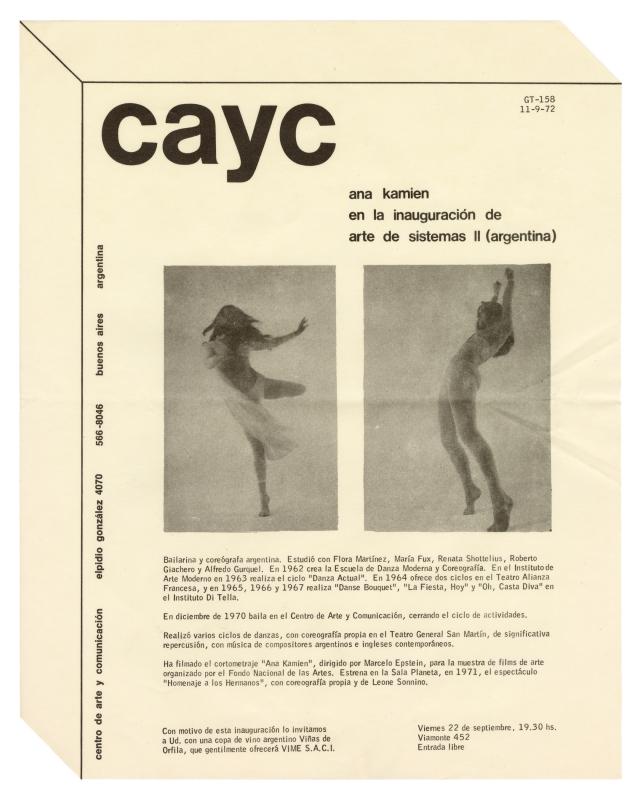Ever since it was founded, the CAYC (Centro de Arte y Comunicación), helmed by the cultural promoter, artist, and businessman Jorge Glusberg, was intended as an interdisciplinary space where an experimental art movement could flourish. The establishment of collaborative networks connecting local and international artists and critics played an important role in this process. The exhibitions shone a light on these exchanges, in which overviews of trends or individual artists provided an introduction to the innovations of international contemporary art and made Argentine and Latin American artists better known on the global scene.
Just as the opening of Arte de Sistemas Argentina (Centro de Arte y Comunicación, see GT-158 [doc. no. 1476342]) included a performance choreographed by Ana Kamien, Opresión- lucha-liberación was presented at the opening of CAYC al Aire Libre. Arte e Ideología (Plaza Roberto Arlt). This contemporary dance project was created by Nélida Puig and Lidia Andino at CAYC al aire libre. Arte e Ideología, one of the three exhibitions that were presented during Arte de Sistemas II.
The exhibition Arte de Sistemas II (Buenos Aires, September 1972) was presented at three different venues: Arte de Sistemas Internacional (Museo de Arte Moderno in Buenos Aires), Arte de Sistemas Argentina (Centro de Arte y Comunicación), and CAYC al Aire Libre. Arte e Ideología (Plaza Roberto Arlt). There was also a performance of experimental music. The idea that art could be shown outside of the traditional exhibition circuits had already been explored in events such as CAYC al aire libre. Escultura, follaje y ruido, which took place at the above-mentioned plaza in November 1970. The complex logistics involved in organizing three exhibitions led to the inclusion of a greater variety of trends and movements being developed in local art circles, which were mainly reflected in gestural, participatory, and ephemeral art, and strictly contemporary works of a political nature.
The artists’ works were very focused on social issues and influenced by Louis Althusser’s Marxist ideas, the theory of dependence, and the dialectic of oppression that was in vogue throughout Latin America. The turbulent situation in Argentina and other Latin American countries and the chance to create art that demanded social change were on open display in a public space. The exhibition of works, which opened on September 23, 1972, echoed the social and political conditions of the times. Two days later it was shut down and the works were confiscated by the police. The exhibition of art in the street defied the repressive limits imposed by the authoritarian government that took power in 1966.

